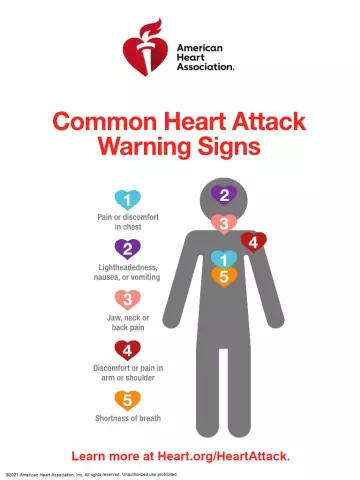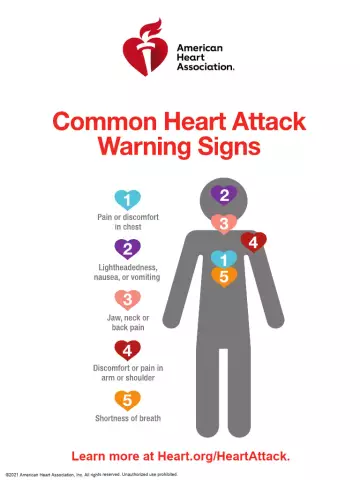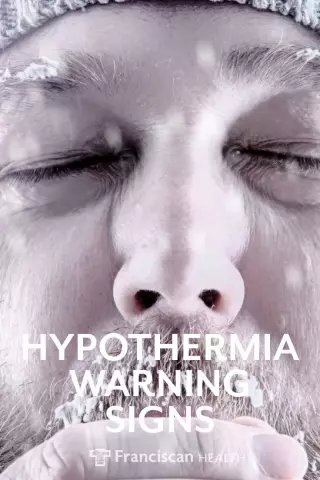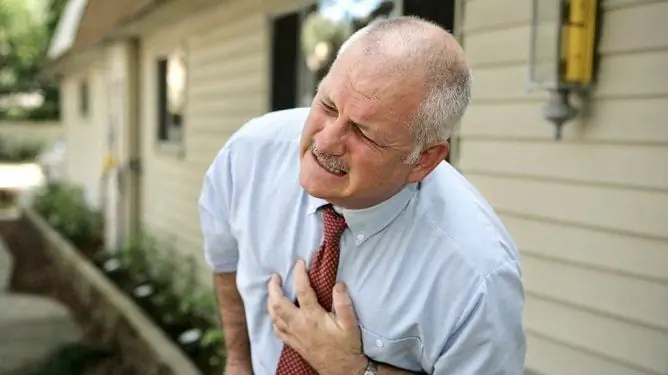- Author Rachel Wainwright [email protected].
- Public 2023-12-15 07:39.
- Last modified 2025-11-02 20:14.
First aid for a heart attack
Myocardial infarction is an emergency condition that occurs due to an acute violation of the blood supply to the heart muscle. This condition is directly life threatening, and therefore requires the adoption of urgent measures of assistance in the acute period, as well as adequate treatment after its transfer.
The mechanism of formation of a heart attack

Most often, a heart attack occurs in elderly patients suffering from ischemic heart disease due to atherosclerosis of the coronary vessels. Translated from medical terminology, this means that the vessels supplying blood to the heart, due to the fact that their lumen is significantly narrowed (as a result of atherosclerosis), do not cope with their duties and do not deliver a sufficient amount of blood to the area of the heart muscle they feed. This condition is called ischemic heart disease ("ischemia" - in Latin means a lack of blood). When the lumen of the vessel is completely blocked, and blood generally ceases to flow through it, a heart attack occurs. With a heart attack, the area fed by the damaged vessel dies after 30-45 minutes, so it is important that first aid is provided during this time.
The extent of the infarction is determined by the size of the affected area of the heart muscle. A heart attack can be so extensive and located in such a way that the heart can no longer perform its functions, and the person dies. On the contrary, there are cases of microinfarction - when a small vessel is damaged, so small that a person does not even notice the moment when a heart attack occurs, but it is discovered only by chance, during examination for another reason.
Nevertheless, without exception, all cases of acute disturbance of the blood supply to the heart muscle pose a serious danger that should not be underestimated. The fact is that after a heart attack, the affected area of the myocardium is no longer restored; a scar of fibrous tissue forms in its place. The contractile ability of the heart muscle deteriorates, which means that the function of the heart as a whole is irreversibly deteriorated.
Signs of a heart attack
As mentioned above, heart attacks are more common in older people who already have heart disease. However, there are often cases when a person does not even realize that his heart is working with disorders, a heart attack can occur even in young people. Therefore, it is important to know the signs of a heart attack and be able to provide first aid, even if there are no people at risk in your environment.
So, the main signs of a heart attack:
- Heart pain of high intensity and duration - from a quarter of an hour to several hours. The pain is localized behind the sternum, but can be given to the arm, shoulder blade, shoulder, neck. It differs from an attack of angina pectoris in that taking nitroglycerin does not help to stop the pain syndrome;
- Fear of death. Often, after suffering a heart attack, patients note that this fear is irrational;
- Deterioration of the general condition: pallor of the skin or vice versa, unhealthy redness, cold sweat, shortness of breath.
In addition to the "classic" signs of a heart attack, there are also atypical ones, in which only a specialist can recognize a heart attack. Nevertheless, they are also worth knowing in order not to miss the danger.
Abdominal infarction (from the Latin "abdomen" - stomach) - a heart attack disguised as an intestinal disorder. Its signs are nausea, vomiting, stool disturbance, against which background palpitations, shortness of breath and weakness often go unnoticed.
Asthmatic infarction - resembles an asthma attack, with no or minor pain in the heart. The patient suffocates, but the medications that usually relieve an asthma attack do not help.
Cerebral (cerebral) infarction - the condition proceeds like a stroke. It manifests itself as a violation of speech, coordination of movements, the appearance of an acute headache (as in a stroke) is possible.
Silent heart attack - according to the general opinion of cardiologists, this is the most dangerous form of heart attack, which does not attract attention for a long time, since there are practically no signs of an acute condition. The patient notes only a slight deterioration in the general condition, he has shortness of breath and weakness, especially when moving, but at the same time he, as a rule, continues to lead a normal life. The dumb option is dangerous in that neither first aid nor specialized cardiac care is provided in a timely manner, meanwhile, the functioning of the heart deteriorates.
As a rule, in these cases, a heart attack is detected during an electrocardiogram, therefore, it is prescribed almost always when a patient goes to a doctor with serious discomfort.
First aid for heart attack

If you suspect a heart attack, you should immediately call an ambulance, and it is important to indicate to the operator that it is cardiac care that is required - in this case, a specialized team will be sent with the necessary equipment at its disposal.
Further measures for first aid for a heart attack are as follows:
- Lay the patient to bed, provide fresh air: open a window or window, loosen tight clothing;
- Give a nitroglycerin tablet under the tongue. Despite the fact that with a heart attack nitroglycerin is not able to relieve a painful attack, the drug still has a therapeutic effect. Attention! - while waiting for the arrival of an ambulance, you can give no more than three tablets of nitroglycerin;
- Give the victim a tablet or two aspirins (also known as acetylsalicylic acid). Aspirin promotes blood thinning, thereby improving the blood supply to the heart in ischemic conditions, in addition, it has an analgesic effect. The tablet must be chewed - so the effect of the drug will appear faster.
If the patient has lost consciousness, and the pulse cannot be felt or has become threadlike, it is necessary to immediately start resuscitation:
- Apply a short, strong punch to the sternum, the so-called. precordial stroke. In the absence of special tools, it can act as a defibrillator and restart the stopped heart. The blow should be applied once;
- If the precordial stroke did not have the desired effect, immediately begin to do chest compressions, while artificially ventilating the lungs using one of the methods - mouth-to-nose, mouth-to-mouth. This must be done before the arrival of an ambulance.
Found a mistake in the text? Select it and press Ctrl + Enter.






